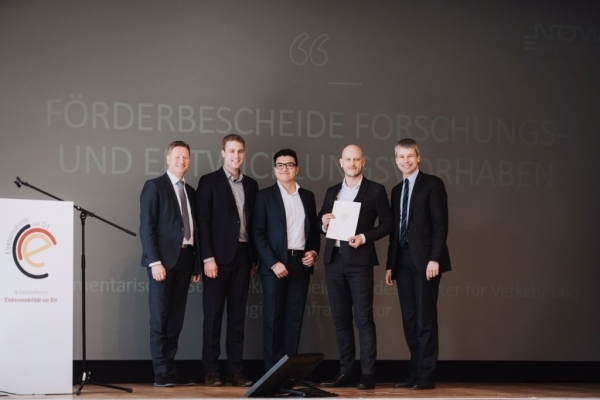28.3.2019. Start free for the Nissan, initiated the project “i-recipe”: The Federal Ministry of transport and digital infrastructure (BMVI) supports the project financially within the framework of the Funding guideline electromobility.
The funding decision was made on Tuesday, 26. March of 2019, within the framework of the 6. BMVI conference “electric mobility on-the-spot” presented in Bad Cannstatt.
“i-recipe” stands for “intelligent regenerative electric vehicles for on-site power maximisation and the primary control power market participation”. The Nissan together with the Fraunhofer Institute for industrial engineering IAO and for manufacturing technology and Applied materials research IFAM, launched the project explores opportunities and business models, which offers the Integration of electric vehicles into public and private power networks. Nissan for the project, among other things, the vehicles and the Charging infrastructure.
In the framework of field tests should be shown that electric vehicles with the electricity grid, as well as with property of any kind (e. g. A-/multi-family houses, commercial buildings) pair. The batteries of the electric vehicles can serve as a buffer for excess energy from local renewable sources: solar energy produced on the roofs of single-family homes and Neighbourhoods, and in the private electric the residents vehicles save between.
At the same time, E could be vehicles in the future, on financially attractive primary control power market. A critical mass of regenerative electric a provision of primary control power, and thus a reliable energy supply can be guaranteed vehicles. With the project, the partners want to find out how high the critical mass in dependence of vehicle use and of the respective building.
For regeneration of energy in a local or public power grid, electric vehicles need, in principle, a bi-directional charging technology, also known as Vehicle-to-Grid (V2G) technology. The Nissan Leaf brings the technical requirements: It can not only refer to electricity from the grid, and in traction battery save, but when you need to feed it back.
“In the case of electric mobility, it’s not just a question of how we come as clean as possible and compatible with the environment from A to B,” says Nissan managing Director Guillaume Pelletreau. “We need a holistic approach that takes into account all the actors on the electricity market and in energy supply. Electric cars with bi-directional charging technology, such as our Nissan Leaf play an important role. We are looking forward to explore this role with the help of our project partners and the support provided by the Federal government.“
The project “i-recipe” will be promoted in the framework of the Funding guideline electromobility with a total of 2.391.517,30 euros by the Federal Ministry of transport and digital infrastructure. The entire project budget of the consortium is 3.839.059 Euro. The NOW GmbH National Organisation hydrogen and fuel cell technology coordinates and controls the electric mobility of the BMVI.


State support for the electric car project “i-recipe” – Presentation of the funding decision
Start free for the Nissan, initiated the project “i-recipe”: The Federal Ministry of transport and digital infrastructure (BMVI) supports the project financially within the framework of the Funding guideline electromobility. The funding decision was made on Tuesday, 26. March of 2019, within the framework of the 6. BMVI conference “electric mobility on-the-spot” presented in Bad Cannstatt. Persons from left to right: Dr. Klaus Bonhoff (managing Director, NOW GmbH), Andreas Freymann (Fraunhofer IAO), Kevin Hochstätter, Oliver Franz (both Nissan center Europe GmbH) and Steffen Bilger (Parliamentary state Secretary to the Federal Minister for transport and digital infrastructure)
(Photo: Nissan)
Nissan LEAF 40 kWh: electric power consumption (kWh/100 km): combined, from 20,6 19,4; CO2-emission, combined: 0 g/km; efficiency class: A+.
The specified values were determined in accordance with the stipulated measuring method in accordance with VO(EC) 715/2007 in the currently applicable version 2017/1347 (WLTP).
Zero CO2 emissions during use (use of energy from renewable sources). Wear parts are not included. The figures do not refer to to individual vehicle and are not part of the offer, but serve alone comparison purposes between the different vehicle types. Further information on official fuel consumption and the official specific CO2 emissions and power consumption of new passenger can be removed from the carriage motor to the “guide on the fuel economy, CO2-emissions and power consumption of new Passenger cars”, of the hand (DAT) is a German automobile litter available for free. The fuel consumption/power consumption and the CO₂ emissions of an electric vehicle depends on the efficient use of the fuel/energy content of the battery by the electric vehicle, and by the driving behaviour and other non-technical factors (e.g. environmental conditions).